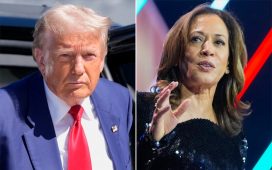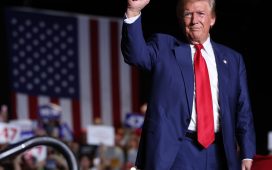Even as gleeful Democrats spent days circulating video clips and memes of Kamala Harris ridiculing and riling Donald Trump in Tuesday’s presidential debate, the candidates themselves got back to the brutal grind of winning over the tiny proportion of voters who will decide November’s election in a clutch of swing states.
Harris is on a “New Way Forward” tour of pivotal areas this weekend to exploit the momentum from her humiliation of Trump. On Friday, she was in Pennsylvania, perhaps the most crucial of crunch states, to push the themes she hit hard in the debate in painting the former president as a threat to democracy, women’s rights and the US’s international standing.
Trump is in Arizona on Saturday and then headed to Michigan, both states he narrowly won in 2016 and then lost four years later, as he attempts to recover from what was widely recognised to be a damaging performance.
The contest for the White House remains on a knife edge.
Before the debate, Harris’s narrow lead in the polls was being chipped away by a Trump campaign trying to claw its way back from the shock of Joe Biden exiting the contest. After Trump’s poor debate showing, Harris appears to be edging up again. But neither campaign is taking anything for granted and both are returning to the daily fight.
A CNN poll showed that 63% of debate watchers thought Harris won as Trump made outlandish claims about immigrants eating family pets and Democrats wanting to kill newborn babies. A focus group of undecided swing state voters put together by the Washington Post overwhelmingly said Harris came out on top.
Even Fox News conceded the defeat. Its political analyst, Brit Hume, said Trump spent too much time airing old grievances that do nothing to win votes.
“Let’s make no mistake, Trump had a bad night,” he said.
Still, more cautious Democrats recognised that one bad night for the former president is far from a knockout blow and that their candidate remains particularly vulnerable on the economy, the top issue for large numbers of voters hit by surging inflation.
The CNN poll showed that confidence in Harris to handle the economy fell by two points to 35% because of the debate after she failed to address inflation, or even acknowledge the hardship it has caused, while trust in Trump on the issue rose by two points to 55%.
And while the latest YouGov poll gives Harris a nine-point advantage over Trump in favourability ratings, the presidential race is still neck-and-neck with each candidate claiming the support of 45% of the electorate.
Charles Franklin, director of the respected Marquette Law School polling of voters in the swing state Wisconsin, where only about 20,000 votes separated Trump and his opponent in the last two presidential elections, said that while it was clear Harris won the debate, he doubted the outcome would shift the dial very much in those states where the election will be decided.
“The question is, how much does it move the electorate in Wisconsin? Our electorate is pretty highly polarised even by national standards and so moving it much seems a little far-fetched,” he said.
“The trouble is that voters always go to debates looking at it through their partisan glasses. If their candidate is clearly doing poorly, they come up with reasons why that is that still doesn’t lead them to reconsider their support for that candidate.”
Swathes of Trump supporters lamented his performance but then shifted the blame to the debate moderators by accusing them of picking on the former president while giving Harris an easy ride.
Polling says that about one in 20 voters in swing states have yet to make up their minds about who to vote for. But political analysts are sceptical that so many people are really undecided when Trump is such a known and divisive candidate.
Nicholas Valentino, a professor of political science at the University of Michigan, said that even though Harris’s positions are not particularly well-known, few people can be in doubt about the differences between the contenders on key issues from abortion to immigration and healthcare.
“There are very few undecided voters left in the electorate at this point in the campaign. When those undecided voters say we need more substance from either of the candidates, it doesn’t necessarily mean that they don’t know the differences or that they’re really waiting for some key piece of information that will tip the scales. That’s ambivalence. It’s not ignorance about where the candidates stand,” he said.
Franklin said his polling showed that when uncommitted voters in Wisconsin are pressed about the reasons for their indecision, it often has less to do with policies or individual candidates than how they feel about politics in general.
“The fact that they are negative towards politics, though, also sounds like many of Trump’s supporters, and that is one argument to think that Trump might have an advantage winning over those folks who are undecided but very negative about politics,” he said.
Nonetheless, the YouGov poll shows Harris has the opportunity to make headway with voters who say they favour a candidate but are open to changing their minds. Four per cent of Trump supporters would consider voting for Harris while just 1% of Democrats are prepared to contemplate switching. But many of those Trump supporters see the economy as the most important issue. A majority of voters continue to view the former president’s tenure in the White House as a time of greater prosperity and have much more confidence in him to improve their finances.
For all that, Harris’s combative approach to the debate was informed by the recognition in both campaigns that the key to victory almost certainly lies in turnout and generating enthusiasm among ambivalent supporters.
In 2016, Trump beat Hillary Clinton in Pennsylvania by fewer than 45,000 votes out of nearly 6m cast. Four years later, Trump increased his vote in the state by more than 400,000 ballots. But he still lost Pennsylvania in 2020 because Biden was able to boost the Democratic turnout by 530,000 votes.
That was a pattern repeated across swing states that delivered a Biden victory and that Harris must now almost certainly win. Probably no state is more pivotal than Pennsylvania.
“It’s mostly now about the turnout game,” said Valentino. “It’s very likely that this election in Pennsylvania will be decided by fewer than 100,000 votes, just like it has been in the last two elections. There are many, many voters in Pennsylvania – white, less-than-college-educated men, women in the suburbs around the big cities – that each respective camp is going to be trying to turn out.”
Polling shows that enthusiasm for the election among Democrats shot up after Biden dropped out of the race in July. Franklin saw it in Wisconsin.
“Democrats are now running about nine points ahead of Republicans in enthusiasm, which certainly seems to point to another very high-turnout election,” he said.
The YouGov poll shows that, nationally, 72% of Harris supporters say they are extremely or very enthusiastic about voting. Only 67% of Trump supporters say the same. But enthusiasm is significantly lower among younger people, whom the Democrats need. Only 78% of under-30s say they are likely to vote, compared with 95% of over-45s, who lean toward Trump.
Harris continues to alienate some Democrats who outright refused to vote for Biden, calling him “Genocide Joe” over US support for Israel’s war in Gaza, which has killed more than 40,000 Palestinians. Harris sought to defuse the issue during the debate by saying that “far too many innocent Palestinians have been killed”, but that prompted critics to ask: how many innocent deaths is too many?
The Democrats were particularly worried about the impact of Gaza policy on the significant Arab American vote in swing state Michigan, but Valentino thinks it has lost some of its sting, particularly among younger voters now focused on concerns about Trump returning to power.
After the debate, Harris faced criticism for spending her time taunting Trump instead of detailing economic policy and a political vision. But Democratic strategists are only too aware that the surge in turnout for Biden in 2020 was less about support for the candidate than to get Trump out of the White House.
Valentino said Harris’s approach may have served her well in that regard.
“Her campaign strategy in this debate was clearly to allow Trump to display this kind of intense anger and goad him into making highly questionable arguments that they would cause moderates, and maybe even some moderate Republicans, to either become disillusioned with Trump and stay home from voting,” he said.
“The other reason she was doing this is to mobilise her own base. Young people are worried about the future of democracy. I have data that shows the issue of protecting electoral institutions and elections is a very mobilising issue for Democrats, especially young Democrats. They know that they’re going to have to live and vote in this country for a lot longer than older folks and they are really worried about democratic institutions. That’s an issue that’s very potent for the Democratic party and for Harris, and she’s trying to make the most of it.”






